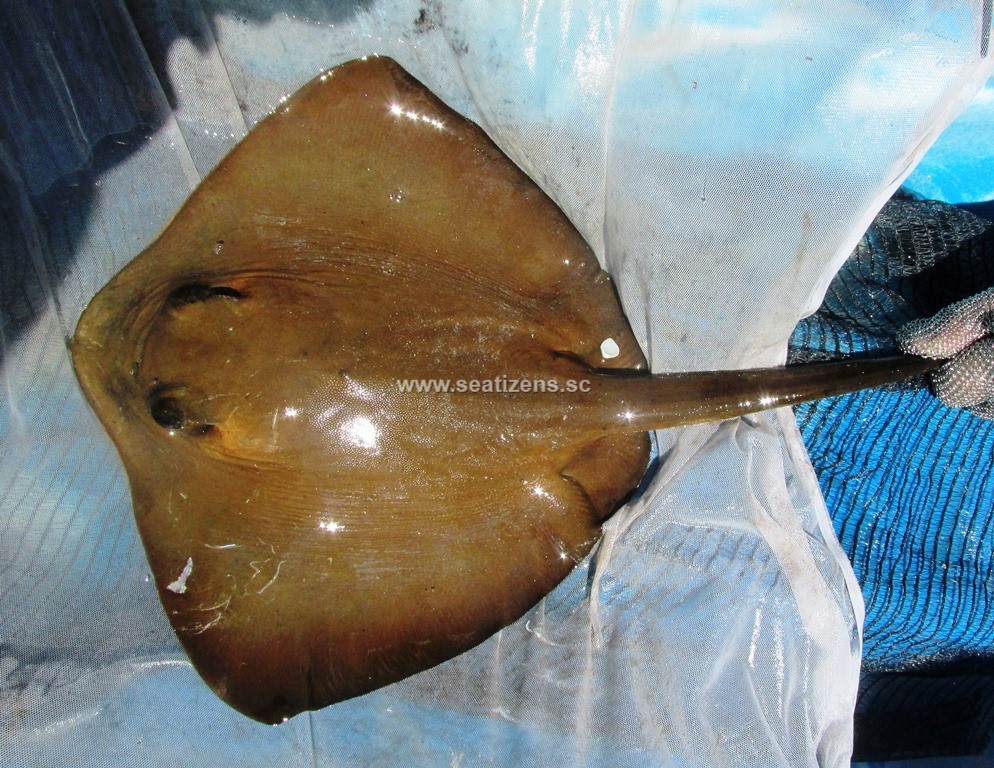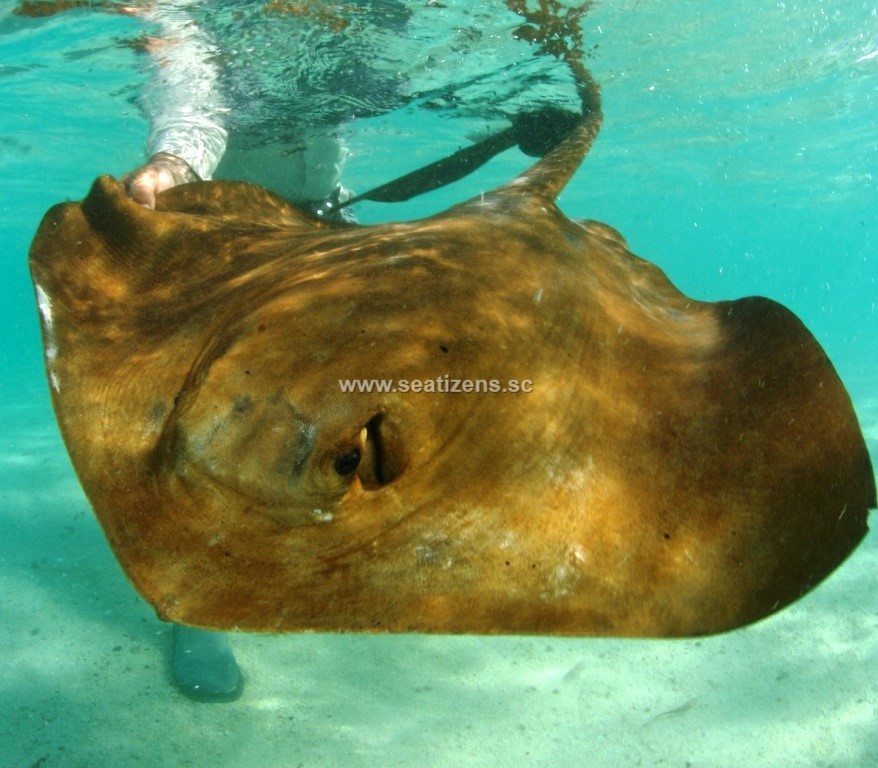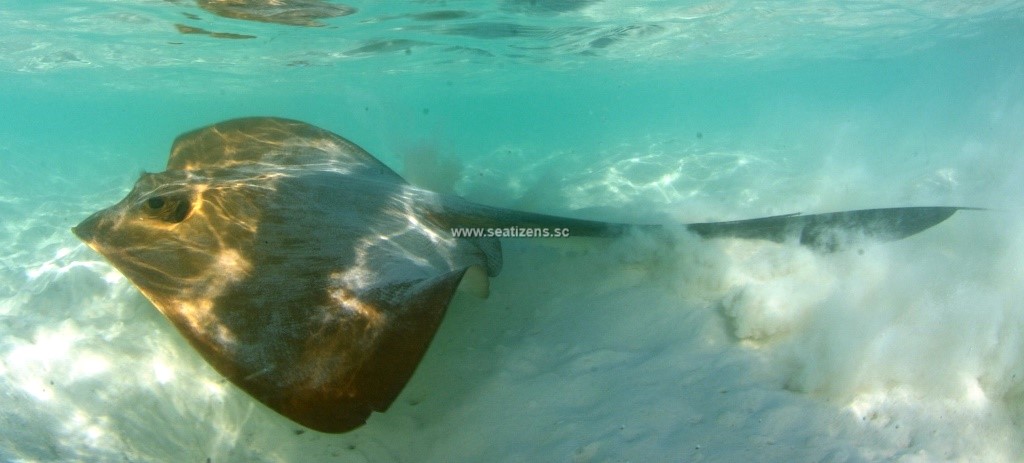Description:
Large Stingray with a broad rhombic disc (slightly wider than long, disc width 1.2 to 1.3 times its length). Dense band of blunt denticles form wide band on
central disc in adults.Small heart-shaped or starry based thorns on mid-shoulder.Usually four small thorns on shoulder often barely larger than surrounding denticles. Small
eyes with wide interorbital space. Mouth small, not greatly protrusible, 5 oral papillae. Nostrils slit like, oblique. Nasal curtain skirt-shaped.Snout short, obtuse,
with small lobe at tip and without denticles. Anterior margin straight, apices angular and thick trunk. Very broad tail base and flattened anteriorly, becoming more
cylindrical distally, about twice disk width or less, with a posteriorly located sting, the ventral skin fold is very deep but does not reach the tail apex. Pelvic fins
large, tips narrowly rounded.
Colour. Uniform dark greyish brown to black dorsally, often with fine black edge around disc and pelvic fin, and white ventrally. Tail fold and tail tip black undersurface
white, ventral tail with black areas before sting.
Similar to and often confused with cowtail ray see notes section below.
Size:
Lm unknown. Max disc width 200cm. Max Length > 300cm TL.
Born at approximately 18cm disc width.
Habitat and Ecology:
Demersal on continental and insular shelves (depth 0 - 60m). Mainly marine but ventures into estuaries and freshwater.
Reproduction is viviparous with a litter size of two pups. Little else is known of its biology.
Until recently this species was not known to occur in Seychelles, it being believed that all specimens seen were actually of the very similar species Pastinachus sephen.
Chantel Elston however (Elston 2018) found with DNA analysis that the Cowtail rays at St Joseph Atoll in the Amirantes were P. ater and not P. sephen.
Fishery Status:
This species is not protected or subject to fishery regulations. It is presumed that where it occurs it would be vulnerable to the net and harpoon fishery.
Notes:
Similar species. Similar to and often confused with cowtail ray which is the more common of the two species where they co-occur in the western Indian Ocean.
These species differ subtly in morphology, denticle structure and distribution, and at a molecular level.
Until recently this species was not known to occur in Seychelles, it being believed that all specimens seen were actually of the very similar species Pastinachus sephen.
Chantal Elston however (Elston 2018) found with DNA analysis that the Cowtail rays at St Joseph Atoll in the Amirantes were P. ater and not P. sephen. Further work
is required in the central archipelago to determine whether P. ater occurs there and if so if it does in co-occurrence with P. sephen or exclusively. Specimens examined
in the central archipelago to date by J. Nevill exhibit the spine count typical of P. sephen.
Photos provided courtesy of Chantel Elston and Rainer von Brandis respectively.
References:
Elston, C. (2018). The Trophic and Spatial Ecology of a Sympatric Dasyatid Community at a Remote Atoll, Seychelles. A thesis submitted to Rhodes University
in fulillment for the the degree of DOCTOR OF PHILOSOPHY, Department of Ichthyology and Fisheries Science, Faculty of Science.
Froese, R. and D. Pauly. Eds. (2021). Pastinachus ater https://www.fishbase.se/summary/Pastinachus-ater.html (19/04/21).
Last, P.R. et al (2016). Rays of the World. CSIRO Publishing ISBN 9781501705328
McGrouther, M. (2021). Cowtail Stingray, Pastinachus ater (Macleay, 1883). Australian Museum
https://australian.museum/learn/animals/fishes/cowtail-stingray-pastinachus-sephen-forsskal-1775/ (19/04/21).
Pastinachus ater (MACLEAY, 1883): In: Database of modern sharks, rays and chimaeras, www.shark-references.com, World Wide Web electronic publication,
Version 04/2021 https://shark-references.com/species/view/Pastinachus-ater (19/04/21).
Sherman, C.S. et al (2021). Pastinachus ater. The IUCN Red List 2021: e.T70682232A124550583. https://dx.doi.org/10.2305/IUCN.UK.2021-1.RLTS.T70682232A124550583.en. (19/04/21)
Citation:
Nevill, J.E.G. & Elston, C. (2021). Pastinachus ater, Broad cowtail ray. Seychelles Seatizens. www.seatizens.sc. https://seatizens.sc/species/pastinachus-ater-macleay-1883/




https://boomerang22.com/
SEO Backlinks via Redirect backlink building
We advise creating external links via redirect and placing a link to sites, while the ranking power of the domains will enhance its SEO value. Backlinks are an crucial indicator in search algorithms! And for domains with high trust, if you create, for example, ten thousand backlinks, this method is perfect, since there is anti-blocking protection and the site is protected from bans.
Therefore, we offer only a high-quality base.
Links stay on the websites forever:
As a result, you will obtain:
– Speedy crawling of your website
– Accelerated improvement of visibility in search engines
– Flow of indexing bots to your site
Backlinks SEO promotion
1. Взаимосвязанные backlinks (чтобы улучшить индексацию).
2. Переадресации через Google.
3. Ссылки через редиректы с доверенных сайтов.
– Отправляю отчет о выполнении через текстовый файл с перечнем успешных размещений.
best cafe near me
Cafe Bateel — A Symphony of Taste and Elegance
Opening the Cafe Bateel menu is akin to hearing the first notes of a grand opera — a melodic beginning that awakens the senses and sets the stage for a memorable culinary experience.
It starts with our delicately crafted soups, followed by a fresh selection of vibrant salads crafted from carefully selected ingredients — from delicate palm hearts to fresh yellowfin tuna. For those seeking something light yet satisfying, Cafe Bateel offers refined standards such as our house special risotto and the classic club sandwich, each crafted with care and culinary precision.
No visit would be complete without savoring our distinctive coffee menu, refreshing beverages, and gourmet treats. Each creation reflects our dedication to culinary excellence and artistry, ensuring every taste leaves a lasting impression.
Cafe Bateel is also renowned for its signature breakfast menu. From freshly made Belgian waffles and classic eggs Benedict to freshly baked croissants, muffins, and Danish pastries, every morning becomes a moment of pure pleasure.
Cafe Bateel is more than just a cafe — it is a journey of taste, where every nuance, ingredient, and tone blends in perfect balance. Whether you begin your morning with a freshly baked treat or delight in an unhurried lunch, each visit invites you to savor the art of refined dining.
Aumentará la confianza en el sitio web
Grado de autoridad del dominio (DR de Ahrefs)
Aumentará la credibilidad en el sitio web.
El rendimiento de tu sitio web es fundamental para el SEO.
Nos encargamos de dirigir robots indexadores de Google a tu sitio para optimizar su posición.
Existen 2 categorías clave de robots de búsqueda:
Bots de rastreo – los que analizan inicialmente el sitio.
Indexing robots – entran bajo la instrucción de los crawling robots.
Cuantos más accesos hagan estos robots a tu sitio, mayor será tu visibilidad.
Antes de comenzar, te entregaremos una prueba visual del DR desde Ahrefs.
Después de concluir el trabajo, también obtendrás una muestra actualizada del valoración de tu sitio en Ahrefs.
Solo pagas si hay resultados.
Plazo aproximado: de poco más de una semana.
Aceptamos sitios con DR hasta 50.
Para procesar tu pedido necesitamos:
Un enlace de tu sitio web.
Una keyword.
Las plataformas sociales quedan excluidas del servicio.
https://crazytime-bangladesh.com/
Website backlinks SEO
You can find us by the following search terms: links for site promotion, links for SEO purposes, Google backlinks, link acquisition, link builder, receive backlinks, backlink service, web backlinks, purchase backlinks, Kwork-based backlinks, website backlinks, website SEO links.
Backlinks for your site
Functional throughout all themes of the resource.
I create external links to your domain.
These backlinks draw in Google crawlers to the platform, something that is crucial for search visibility, so it matters to enhance a platform without issues that will interfere with visibility.
Placement poses no risk for your platform!
I avoid filling in feedback boxes, (contact forms negatively impact the resource due to complaints from administrators).
Submission takes place in allowed areas.
Backlinks are placed to their latest regularly updated database. Several portals in the catalog.
protein shake
Cafe Bateel — A Harmony of Flavor and Refinement
Exploring the Cafe Bateel menu feels like hearing an opera’s opening symphony — a symphonic introduction that awakens the senses and sets the stage for a memorable culinary experience.
It starts with our delicately crafted soups, followed by a fresh selection of vibrant salads crafted from carefully selected ingredients — from soft heart of palm to succulent yellowfin tuna. For those looking for a meal that’s both light and fulfilling, Cafe Bateel offers timeless classics such as our signature risotto and the classic club sandwich, each designed to delight both the eye and the palate.
No visit would be complete without savoring our distinctive coffee menu, invigorating drinks, and indulgent desserts. Each offering reflects our dedication to culinary excellence and artistry, ensuring every mouthful is a moment of pleasure.
Cafe Bateel is also admired for its delightful morning specialties. From homemade Belgian waffles and expertly prepared eggs Benedict to buttery croissants, moist muffins, and flaky Danish treats, every morning becomes a moment of pure pleasure.
Cafe Bateel is more than just a cafe — it is a journey of taste, where every aroma, ingredient, and texture comes together in harmony. Whether you welcome the day with a golden pastry or savor a relaxed midday meal, each visit invites you to savor the art of refined dining.
Seo Backlinks
Backlinks for promotion are a very good tool.
Backlinks are important to Google’s crawlers, the more backlinks the better!
Robots see many links as links to your resource
and your site’s ranking goes up.
I have extensive experience in posting backlinks,
The forum database is always up to date as I have an efficient server and I do not rent remote servers, so my capabilities allow me to collect the forum database around the clock.
https://joker8kazino.com/
Seo Backlinks
Backlinks for promotion are a very good tool.
Backlinks are important to Google’s crawlers, the more backlinks the better!
Robots see many links as links to your resource
and your site’s ranking goes up.
I have extensive experience in posting backlinks,
The forum database is always up to date as I have an efficient server and I do not rent remote servers, so my capabilities allow me to collect the forum database around the clock.
Website backlinks SEO
We are available by the following phrases: backlinks for website, SEO backlinks, links for Google ranking, link building service, link building specialist, receive backlinks, backlink service, site backlinks, acquire backlinks, backlinks Kwork, backlinks for websites, website SEO links.
Backlinks for your site
Applicable across all subjects of the portal.
I create external links to your page.
Such inbound links attract web crawlers to the resource, this is crucial for SEO, thus it’s critical to enhance a domain free of issues that obstruct promotion.
Positioning is safe for your domain!
I don’t submit in feedback boxes, (contact forms negatively impact the platform as there are complaints from the owners).
Placement takes place in approved sources.
Inbound links are inserted to the most recent regularly updated database. Numerous resources in the repository.
Seo Backlinks
Backlinks for promotion are a very good tool.
Backlinks are important to Google’s crawlers, the more backlinks the better!
Robots see many links as links to your resource
and your site’s ranking goes up.
I have extensive experience in posting backlinks,
The forum database is always up to date as I have an efficient server and I do not rent remote servers, so my capabilities allow me to collect the forum database around the clock.
https://ninecasinoceske.com/
Backlinks for your site
Practical on all topics of the resource.
I build external links to your page.
These backlinks direct search crawlers to the page, that is very important for ranking, therefore it is important to enhance a site free of defects that affect negatively ranking.
Placement poses no risk for your domain!
I don’t submit in feedback boxes, (contact forms pose risks to the platform because of reports from operators).
Posting is performed in authorized locations.
Inbound links are posted to updated regularly updated database. A large number of platforms in the repository.
Website backlinks SEO
Our services are accessible by the following keywords: website backlinks, links for SEO purposes, Google-focused backlinks, link acquisition, link building specialist, receive backlinks, link service, site backlinks, purchase backlinks, backlinks via Kwork, site linking, website SEO links.
Seo Backlinks
Backlinks for promotion are a very good tool.
Backlinks are important to Google’s crawlers, the more backlinks the better!
Robots see many links as links to your resource
and your site’s ranking goes up.
I have extensive experience in posting backlinks,
The forum database is always up to date as I have an efficient server and I do not rent remote servers, so my capabilities allow me to collect the forum database around the clock.
Артикул: 1151021 225xR16 108T https://63kolesa.ru/products/legkovye_shiny_goodyear_ultra_grip_ice_arctic_20565_r15_xl_99t_ship
Backlinks for your site
Effective throughout all themes of the portal.
I make backlinks to your page.
Such inbound links direct indexing bots to the platform, that is crucial for ranking, therefore it is important to promote a resource that does not have flaws that affect negatively development.
Insertion poses no risk for your site!
I do not write in feedback boxes, (contact forms negatively impact the platform as there are complaints from the owners).
Publication takes place in permitted places.
Backlinks are posted to the most recent constantly maintained catalog. A large number of platforms in the database.
https://ninecasinoceske.com/
Seo Backlinks
Backlinks for promotion are a very good tool.
Backlinks are important to Google’s crawlers, the more backlinks the better!
Robots see many links as links to your resource
and your site’s ranking goes up.
I have extensive experience in posting backlinks,
The forum database is always up to date as I have an efficient server and I do not rent remote servers, so my capabilities allow me to collect the forum database around the clock.
Website backlinks SEO
Our services are accessible by the following queries: backlinks for website, search engine optimization links, links for Google ranking, link acquisition, backlink creator, get backlinks, backlinking service, web backlinks, acquire backlinks, Kwork backlinks, site linking, SEO-focused backlinks.